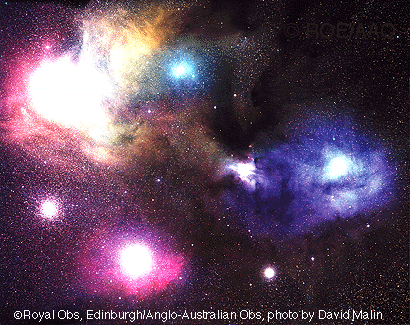 |
Астронет: Астрономическая картинка дня Разноцветные облака около ро Змееносца http://variable-stars.ru/db/msg/1161769/eng |
Credit & Copyright: Royal Observatory, Edinburgh,
Anglo-Australian Observatory
Explanation:
The many spectacular colors of the
Rho Ophiuchi
(oh'-fee-yu-kee) clouds
highlight the many processes that occur there. The
blue regions shine
primarily by reflected light. Blue light from the star rho Ophiuchi and
nearby stars reflects more
efficiently off this portion of the nebula than red light. The Earth's
daytime sky appears blue for the same reason. The
red and yellow regions
shine primarily because of emission of the
nebula's atomic
and molecular gas.
Light from nearby stars - particularly the bright star
Antares in this case - knocks
electrons
away from the gas, which
then shines when the electrons recombine with the
gas. The dark regions
are caused by
dust grains -
born in young stellar atmospheres - which effectively block light emitted
behind them. The
Rho
Ophiuchi star clouds, well in front of the globular cluster M4
visible on far lower left,
are even more colorful than humans can see - the clouds emits
light in every wavelength band from the radio to the gamma-ray.
Information:
The
Scale of the Universe Debate in April 1996
Authors & editors:
Robert Nemiroff
(MTU) &
Jerry Bonnell
(USRA)
NASA Web Site Statements, Warnings,
and Disclaimers
NASA Official: Jay Norris.
Specific
rights apply.
A service of:
LHEA at
NASA /
GSFC
& Michigan Tech. U.
